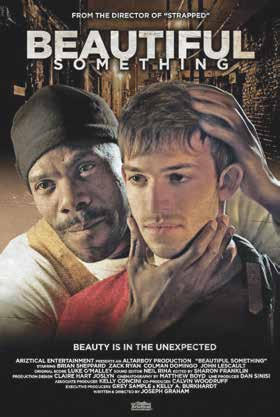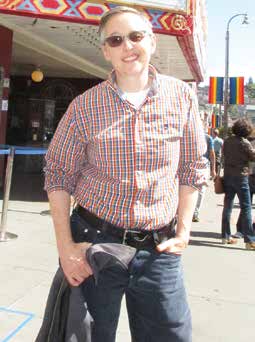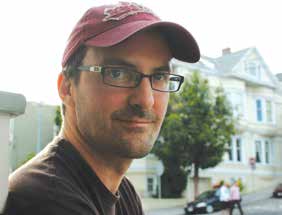 Two San Francisco-based filmmakers have films out on DVD. Writer/director Joseph Graham’s intimate, affecting drama Beautiful Something chronicles four characters whose lives overlap over the course of a night.
Two San Francisco-based filmmakers have films out on DVD. Writer/director Joseph Graham’s intimate, affecting drama Beautiful Something chronicles four characters whose lives overlap over the course of a night.
Brian (Brian Sheppard) is a poet looking for love and inspiration; Jim (Zack Ryan) is an actor who, he says, “goes where my body takes me;” Drew (Colman Domingo) is a famous artist and Jim’s lover; and Bob (John Lescault) is an older man craving companionship.
The stories, which address love and longing, are melancholy slices of life. Graham chatted with me for the San Francisco Bay Times about making Beautiful Something.

Gary M. Kramer: How did you develop the characters and storylines for Beautiful Something?
Joseph Graham: The characters all pretty much came from me. I developed them from my own past experiences and by bringing the actors in and exploring things with them. That’s how they blossomed. I worked with the actors to create the characters, open them up and see who they were.
Gary M. Kramer: Brian Sheppard is fantastic in the film; he makes you believe he falls in love with every guy he meets. Matthew Rios steals his few scenes as Sergio, a pivotal character who flirts with Brian. Can you talk about the casting?

Joseph Graham: I think there is enormous strength in Brian’s portrayal and transformation. It’s his talent and craft, and his wit, and intelligence. Without that, the character would have been weak. Matthew was a really lucky find for us. He came in late to casting. What was wonderful is that he pushed his way right into Brian’s face as they were reading, and we knew he was the guy. He had trouble with the bicycle his character rides—he didn’t know how to ride it! He got what the character was there for in terms of the function of the story. Tying into that gave him the ease and confidence to play things as easily as he did.

Gary M. Kramer: Why did you set and shoot Beautiful Something in Philadelphia?
Joseph Graham: Philadelphia is a city that has been so wonderful to me over the past ten years. My films Vanilla and Strapped screened there, and I made friends there. I consider it a second home. Shooting there afforded us the opportunity to make the film grittier, and give it a stronger backdrop than doing it in San Francisco where I live. It gave it a stronger edge.
Gary M. Kramer: What decisions did you make in what you showed in the film? The sex is explicit, but not erotic.
Joseph Graham: There are parts that people feel are erotic, but I can see where others don’t. It wasn’t going to be about nudity. This isn’t a Cinemax gay movie. There had to be many layers of emotion, connection, vulnerability and loss and intensity and aggressiveness. Those milliseconds where you feel connected and suddenly it’s lost. What’s really played up is that the sex means one thing to one person, and something completely different to the other. When Brian is with Chris [a hookup] it’s passion for Brian, and just carnal need for Chris. Between Zack and Drew, sex is very complex. But when Brian and Jim are kissing in the warehouse, there’s a moment of recognition, but then it is lost.
Gary M. Kramer: Beautiful Something has a real melancholic feel to it, but there is also something quite moving about it.
Joseph Graham: The melancholy quality and the loneliness and the feel of the style of the lighting and the sound, that’s just me. There wasn’t planning with that; it just felt right. There is an aching, a longing, and it’s so ephemeral. It’s impossible for them to put into words. I like a Hopper-esque mood. ________________________Another local mood piece, San Francisco-based Jenni Olsen’s The Royal Road, is out on DVD September 6. An affecting cinematic journey, Olsen’s eloquent documentary consists of gorgeous still shots of empty streets, bridges, and buildings—many of which have a Hopper-esque quality—and her poignant voice-over observations. She chronicles the history of the El Camino Real, while waxing poetically about the “pure industrial beauty” of the Oakland port.
She traces Spain’s colonization of California and provides a brief, but cogent, history lesson about manifest destiny, the territorial expansion of the U.S., and the Mexican-American War. And Olsen discusses nostalgia and love and loss, as well as her flirtations with potential girlfriends (that never quite seem to work out).
The Royal Road is also a nuanced essay/memory piece about movies. Olsen describes the impact films such as Sunset Boulevard, The Children’s Hour, Vertigo, and Roman Holiday have had on her outlook on life. She explains how films provided an escape for her growing up as a tomboy in the Midwest, and how the catharsis of narrative continues to inform her life in San Francisco, where “self-discovery is a civic value.” The Royal Road is very much a trip worth taking.
© 2016 Gary M. Kramer
Gary M. Kramer is the author of “Independent Queer Cinema: Reviews and Interviews,” and the co-editor of “Directory of World Cinema: Argentina.” Follow him on Twitter @garymkramer
Recent Comments